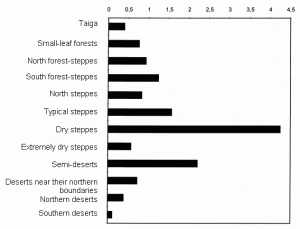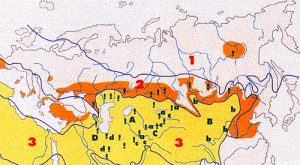Institute for Systematics and Ecology of Animals, SB RAS, Novosibirsk
Novosibirsk State University, Faculty of Natural Sciences,
Department of General Genetics
Head of the Institute:
Vadim I.Evsikov, Corresponding Member of the RAS, Professor
11 Frunze St., Novosibirsk, 630091, Russia
Phone: +7-3832-170863; Fax: +7-3832-170973
email: zoo@zoo.nsk.su
Principal researchers:
M.G.Sergeev, D.Sc., Professor
Phone: +7-3832-397564; Fax: +7-3832-397564
email: icar@fen.nsu.ru
Project objectives
Main goals of the project are to establish patterns of the orthopteran spatial and landscape distribution in North Asia and adjacent countries, to evaluate evolutionary trends of biological diversity of Orthoptera in a changing environment, and to publish the atlas-monograph “Biological Diversity of Orthoptera in North Asia and adjacent Regions”.
Background and significance of objectives
This study is based on the qualitative and quantitative samples collected in North Asia and adjacent countries from 1972 to 1998. Up to date, almost all specimens have been identified. More than 250.000 specimens belonging to 370 orthopteran species have been analysed. These were collected with nets during 3.200 quantitative surveys using nets and species collecting trips. The collections of the Zoological Institute and the All-Russian Institute for Plant Protection (St.-Petersburg), the Institute of Systematics and Evolution of Animals (Krakow, Poland), and some other institutes were studied too. Detailed distribution maps have been compiled for 685 species of Orthoptera inhabiting North Asia and adjacent regions (Fig. 1). Weights of 160 species have been determined.
The orthopteran insects (mainly grasshoppers and locusts) are one of the most important groups of herbivorous animals, especially in grasslands. Their biomass can be high (Fig. 2). In the southern part of Siberia, they can utilise up to 30% of forage. During outbreaks the grasshoppers and locusts they are able to use all local forage. However, this order includes many rare species, including some local endemics. In the temperate regions, the orthopteran outbreak areas are often coincided with centres of diversity and endemism (Sergeev, 1996, 1998) (Fig. 3). As a result, we must change our strategy in management both of pest and rare species. This changing can be realised on the basis of understanding patterns of the spatial and landscape distribution of species, their metapopulations, faunas, and communities.
The orthopteran insects are clearly associated with human activity. The boundaries of their ranges, distribution patterns and population or community dynamics can changes significantly after anthropogenic disturbances. In some cases, these insects can be used as suitable indicators. These are another objectives for studies of their biological diversity and establishment of their spatial and temporal distribution patterns.
Research plan: approaches and methods
Both qualitative and quantitative approaches are used in these investigations. Orthopteran populations and communities are investigated quantitatively, using a number of key sites representative of the geographical location. Disturbed ecosystems are specially studied. Samples captured during a fixed period of time are made in every habitat investigated. Besides that, special faunistic studies are conducted. In a laboratory, species are determined, a dry biomass is evaluated, detailed maps are compiled, population and community distributions are analysed.
Expected results
The main patterns of the orthopteran distribution will be evaluated for North Asia and adjacent regions. The role of human activity will be specially estimated for changing population and community distribution. The atlas-monograph “Biological Diversity of Orthoptera in North Asia and adjacent Regions” will be prepared for publication.
List of publications of participants related to the project
-
Sergeev M.G. Distribution Patterns of Orthoptera in North Asia. – Novosibirsk: Nauka Publ.,1986. – P. 237. (In Russian).
-
Sergeev M.G. Distribution patterns of Orthoptera in North and Central Asia // J. Orth. Res. – 1992. – ą 1. – P. 14-24.
-
Sergeev M.G. La secheresse et les schemas de distribution des criquets en Asie centrale et septentrionale // Secheresse. – 1996. – Vol. 7, ą 2. – P. 129-132.
-
Sergeev M.G. Ecogeographical distribution of Orthoptera. In: S.K. Gangwere et al. (eds.) The Bionomics of Grasshoppers, Katydids and their Kin. – Wallingford, New York, CAB International. 1997. – P. 129-146.
-
Sergeev M.G. Patterns of distribution of phytophagous insects in grass ecosystems of the Holarctic // Biol. Bull. – 1998. – Vol. 25, 4. – P. 357-361.
-
Sergeev M.G. Conservation of orthopteran biological diversity relative to landscape change in temperate Eurasia // J. Insect Cons. – 1998. – Vol. 2. – P. 247-252.
Fig. 1. Distribution of Oedaleus decorus (Germ.).
1 – points of occurrences, 2-3 – range boundaries,
4 – boundaries of uncolonised areas inside the species range
Fig. 2. Dry biomass (kg per ha) of Orthoptera in Western Siberia and Central Asia.
Fig. 3. Distribution of the main centres of diversity and outbreak areas of grasshoppers and locusts in North and Central Asia.
1-3 – biogeographic provinces;
A-D – main centres of diversity; a-d – their subcentres;
! – main areas of outbreaks;
Yellow – arid territories, brown – the semi-arid ones



